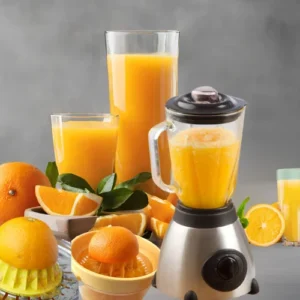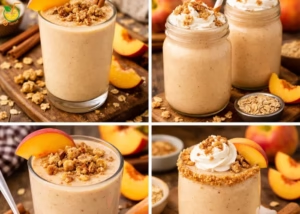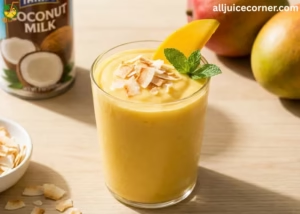How To Make Orange Juice At Home Without A Juicer? Freshly squeezed orange juice is a delightful, nutritious beverage that many enjoy at the start of their day or as a refreshing drink anytime.
Making orange juice at home without a juicer is simpler than you might think.
However, not everyone has a juicer at home, and you might wonder if it’s still possible to enjoy homemade orange juice without one. The answer is a resounding yes!
You can enjoy fresh, nutritious juice anytime with a few household tools and elbow grease.
This article will guide you through several efficient methods to extract orange juice, ensuring you can enjoy this vitamin-packed drink anytime.
Contents
- 1 Benefits of Homemade Orange Juice
- 2 Selecting the Perfect Oranges
- 3 Preparation Before Juicing
- 4 How To Make Orange Juice At Home Without A Juicer?
- 5 Tips
- 6 Other Methods Of Making Orange Juice At Home Without A Juicer
- 7 How To Store Fresh Orange Juice?
- 8 Serving Suggestions
- 9 What Can I Use If I Don’t Have A Juicer?
- 10 How Many Oranges Does It Take To Make Orange Juice?
- 11 Is Homemade Orange Juice Good?
- 12 FAQs
- 13 Conclusion
- 14 How To Make Orange Juice At Home Without A Juicer
Benefits of Homemade Orange Juice
Homemade orange juice is not only refreshing and delicious but also healthier.
You control the ingredients, ensuring no added sugars or preservatives, just pure, vitamin-packed goodness.
Selecting the Perfect Oranges
The secret to delicious orange juice begins with the selection of oranges. Opt for oranges that are firm yet slightly soft, with a vibrant color and a fragrant aroma.
Navel, Valencia, and Blood oranges are excellent choices for juicing, each offering a unique taste profile.
Preparation Before Juicing
Start by thoroughly washing your oranges to remove any pesticides or dirt. Then, cut them into halves or quarters, depending on the juicing method you prefer.
How To Make Orange Juice At Home Without A Juicer?
Making orange juice at home without a juicer is simple and can be a fun, hands-on activity. Here’s a straightforward method to do it:
Ingredients
- Fresh oranges (quantity depends on how much juice you want to make; typically, one medium-sized orange yields about 2-3 ounces of juice)
- Sugar or honey to taste (Optional)
- A pinch of salt to enhance the flavor (Optional)
Tools
- A hand-held citrus reamer or a fork
- A knife
- A strainer
- A bowl or a large measuring cup
- A spoon (if adding sugar or honey)

Instructions
1. Prepare the Oranges:
Start by gently pressing the oranges on a countertop with your palm. This helps break down inner segments and makes the oranges easier to juice.
2. Cut the Oranges:
Use a knife to slice the oranges in half. If you prefer to remove the seeds first, you can do so with a knife or your fingers.
3. Juice the Oranges:
Hold one half of an orange over a bowl or a measuring cup and twist a fork or a citrus reamer into the centre. Squeeze and twist the orange at the same time to extract the juice.
Repeat this process with all the orange halves. If you’re using a fork, you might not get as much juice as with a reamer, but it’s still effective.
4. Strain the Juice:
Place a strainer over a bowl or a jug and pour the juice. This step is optional but helps remove any pulp or seeds that might have fallen into the juice.
If you like pulpy juice, skip the straining step or use a less fine filter.
5. Sweeten (Optional):
If you like your orange juice a bit sweeter or want to enhance the flavor, stir in a little sugar or honey. A pinch of salt can also be added to bring out the sweetness of the oranges.
6. Serve:
It’s ready to serve once the juice is strained and sweetened to your liking. Orange juice is best enjoyed fresh but can be stored in the refrigerator for up to two days.
Tips
➤ Choosing the right oranges is key to delicious juice. Look for oranges that are firm and heavy for their size, as they usually have more juice. Valencia, Navel, and Blood oranges are great choices for juicing.
➤ Temperature affects how much juice you can extract. Room-temperature oranges will yield more juice than cold ones, so if your oranges are refrigerated, let them sit out for a bit before juicing.
Other Methods Of Making Orange Juice At Home Without A Juicer
Method 1: Hand Squeezing Technique
One of the simplest methods to extract juice without a juicer is by hand squeezing.
Cut the orange in half and squeeze each half over a bowl or jug, using your fingers to dig into the segments and extract as much juice as possible.
For a smoother juice, you can strain it through a fine sieve or cheesecloth to remove the pulp and seeds.
Method 2: The Microwave Technique
Warming oranges slightly before juicing can make them softer and easier to squeeze. Microwave the oranges for about 10-20 seconds. Be careful not to overheat, as hot oranges can be difficult to handle.
After warming, use the hand squeezing or fork method to juice the oranges.
Method 3: Blender Method
For a quick and efficient method, blend orange pieces (without the peel) until smooth, then strain the mixture through a fine mesh sieve or cheesecloth to separate the juice from the pulp.
Method 4: Using a Food Processor
Similar to the blender method, process the orange pieces until liquefied, then strain. This method might require a bit more straining to remove all the pulp.
How To Store Fresh Orange Juice?
Store your freshly made orange juice in a tightly sealed container in the refrigerator. It’s best consumed within 2-3 days for optimal freshness and nutritional value.
Serving Suggestions
Serve your homemade orange juice in a chilled glass for a refreshing treat. It pairs wonderfully with a hearty breakfast or as a base for fruit smoothies.
What Can I Use If I Don’t Have A Juicer?
If you don’t have a juicer, no worries! I’ve been there, and I’ve found a few handy alternatives that work just as well.
You can use a fork, a hand-held citrus reamer, or even just your hands to squeeze the juice out of fruits.
A simple kitchen strainer or cheesecloth does the trick for the pulp and seeds. It’s a bit of a workout, but making juice this way is incredibly satisfying.
Plus, you can control how much pulp ends up in your drink. So, grab those fruits and let’s get juicing the old-fashioned way!
How Many Oranges Does It Take To Make Orange Juice?
The number of oranges you’ll need to make orange juice depends on a few factors, like the size and type of the orange and how much juice you aim to make.
Generally, a medium-sized orange yields about 2-3 ounces of juice. So, if you want to make a cup of orange juice (8 ounces), you’d need about 3-4 medium-sized oranges.
Remember, if you prefer your juice less concentrated or the oranges are smaller, you might need a few more.
Is Homemade Orange Juice Good?
Homemade orange juice is fantastic. I find it fresher and more flavorful than most store-bought options.
You control the sweetness and pulp level, making it just right for your taste.
Making it yourself means you know exactly what’s in your glass—no added sugars or preservatives, just pure, vitamin-packed juice.
It’s a bit of effort, but the taste payoff is totally worth it. So, yes, homemade orange juice is not just good; it’s great.
FAQs
Can I Make Orange Juice With The Peel On?
Juice oranges with their peel on are not recommended, as the peel can impart a bitter flavor to the juice. However, a small amount of zest can add a nice zesty flavor.
How Long Does Homemade Orange Juice Last?
Homemade orange juice is best enjoyed fresh but can be stored in the refrigerator in a tightly sealed container for 2-3 days.
Can I Freeze Homemade Orange Juice?
Yes, you can freeze orange juice in an airtight container or ice cube trays. Frozen orange juice can last for up to 4 months but may lose some of its fresh flavor over time.
Why Is My Homemade Orange Juice Bitter?
Bitterness in orange juice is often due to the presence of the white pith of the orange. Try to minimize the amount of pith when preparing your oranges to reduce bitterness.
Can I Add Other Fruits To My Homemade Orange Juice?
Yes! Feel free to experiment by adding other fruits like strawberries, mango, or pineapple to create your own juice blends.
Conclusion
Making orange juice at home without a juicer is feasible and immensely satisfying.
This simple process allows you to enjoy a nutritious beverage and connects you to nature’s raw, unadulterated flavors.
Whether you prefer the traditional method of hand squeezing or opt for using a blender or food processor, the key is to start with ripe, flavorful oranges.
Following the methods outlined in this guide, you can easily incorporate homemade orange juice into your daily routine, adding a burst of natural sweetness and vitamin C to your diet.
So, grab some oranges and start juicing today!
Embrace the simplicity and wholesomeness of homemade orange juice and elevate your health and well-being.
Remember, the freshest, most delicious orange juice is the one you make yourself. It’s a simple pleasure that’s both nutritious and satisfying. Happy juicing!
How To Make Orange Juice At Home Without A Juicer
Equipment
- A hand-held citrus reamer or a fork
- A knife
- A strainer
- A bowl or a large measuring cup
- A spoon (if adding sugar or honey)
Ingredients
- Fresh oranges quantity depends on how much juice you want to make; typically, one medium-sized orange yields about 2-3 ounces of juice
- Sugar or honey to taste Optional
- A pinch of salt to enhance the flavor Optional
Instructions
Prepare the Oranges:
- Start by gently pressing the oranges on a countertop with your palm. This helps break down inner segments and makes the oranges easier to juice.
Cut the Oranges:
- Use a knife to slice the oranges in half. If you prefer to remove the seeds first, you can do so with a knife or your fingers.
Juice the Oranges:
- Hold one half of an orange over a bowl or a measuring cup and twist a fork or a citrus reamer into the centre. Squeeze and twist the orange at the same time to extract the juice.
- Repeat this process with all the orange halves. If you’re using a fork, you might not get as much juice as with a reamer, but it’s still effective.
Strain the Juice:
- Place a strainer over a bowl or a jug and pour the juice. This step is optional but helps remove any pulp or seeds that might have fallen into the juice.
- If you like pulpy juice, skip the straining step or use a less fine filter.
Sweeten (Optional):
- If you like your orange juice a bit sweeter or want to enhance the flavor, stir in a little sugar or honey. A pinch of salt can also be added to bring out the sweetness of the oranges.
Serve:
- It’s ready to serve once the juice is strained and sweetened to your liking. Orange juice is best enjoyed fresh but can be stored in the refrigerator for up to two days.

Welcome to alljuicecorner.com, your go-to resource for all things juice! I’m Marina, the passionate juice enthusiast and health advocate behind this vibrant community. My journey into the world of juicing began five years ago, sparked by a desire to embrace a healthier lifestyle and explore the nutritional power of fruits and vegetables. I spent countless hours researching, experimenting with different combinations, and understanding the science behind each sip.
I bring a wealth of knowledge and practical experience to the juice table. My mission is simple: to share the joy and health benefits of juicing with as many people as possible. Through “alljuicecorner.com,” I aim to demystify the world of juicing, offering easy-to-follow recipes, tips on selecting the right produce, and insights into the health benefits of various ingredients. Whether you’re a seasoned juicer or just starting, this blog is designed to be your companion on this delicious journey.





I sincerely admired what you’ve produced here. The sketch is elegant, your written content chic, yet you appear to have developed some anxiety regarding what you aim to offer thereafter. Certainly, I shall return more frequently, just as I have been doing almost constantly, should you uphold this incline.
Thanks for sharing your important opinion.